Recent Storm Damage Posts
Flood Water Is Almost Always Considered Blackwater
8/24/2022 (Permalink)
 There are three water categories.
There are three water categories.
When a Highland Beach, FL, business floods, it’s generally considered black water, which is equivalent to sewage. That means it needs to be handled with extra care as it may contain significant levels of contaminants.
Flood Water Categories
Unless you can trace the flood water directly to its source — and the source is potable — it’s going to be regarded as unsanitary. If it has traveled a long way outside or come into contact with hazardous waste, it needs to be handled by professionals. It’s broken down into three categories:
Category 1: If the water damage is from a water supply line in your own business and hasn’t picked up a lot of debris or toxic substances, it can often be treated as category 1, which is sanitary.
Category 2: Water that leaks from a dishwasher or washing machine is considered category 2, which has some risk. Rainwater leaking in from your roof also is usually category 2. It requires some special handling but is not considered black water.
Category 3: This is black water. It is considered dangerous and must be cleaned by top storm damage specialists. OSHA and Highland Beach, FL, have laws that require businesses to be sanitized after a flood before employees and especially customers are allowed back in. Insurance companies may even deny claims if they discover you failed to clean up after a flood.
Serious Sanitization
Category 3 water requires a deep cleaning with custom, proprietary agents. Most experts recommend SERVPROXIDE or Benefect Decon-30 for commercial storm damage cleaning. These sanitizers decontaminate many surfaces and are applied using saturated towels or unique ultra-low volume foggers or misters.
Satisfied Customers
When customers or tenants walk into your building, they get an immediate impression of how clean it is. The look, the feel, and particularly the smell of a store or residence can be the difference between high traffic and bankruptcy.
If handled well, flood water damage can be mitigated and your business restored to its condition before the storm. If mishandled, it can chase off residents, employees, and customers in droves.
5 Steps of Flood Cleanup
6/13/2022 (Permalink)
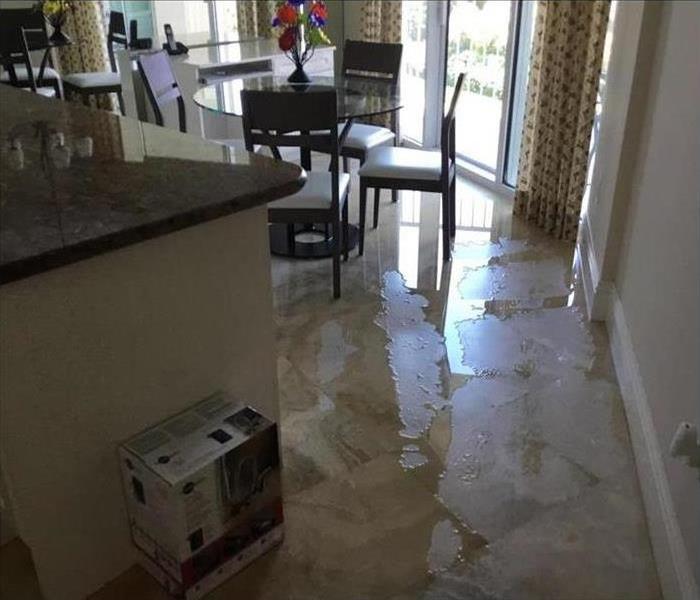 When your home in West Boca Raton, FL, gets flooded, it easily creates a stressful situation but one that needs immediate attention
When your home in West Boca Raton, FL, gets flooded, it easily creates a stressful situation but one that needs immediate attention
Flood Cleanup in 5 Easy Steps
When your home in West Boca Raton, FL, gets flooded, it easily creates a stressful situation but one that needs immediate attention. As you start dealing with the mess, it’s important to follow the cleaning requirements below.
1. Wear PPE
While a simple sink overflow may not require anything more than a towel and bucket, any water issues that come from natural flooding or sewage issues require wearing safety gear. These types of water sources mean the water has potential contaminants. It is recommended to wear safety goggles, a face mask, a long-sleeved shirt, and long pants.
2. Remove Water-logged Items
Once your insurance provider gives the go-ahead, remove any items that are water-logged. From clothes to mattresses and papers, the longer they sit in the home, the more chances that mold will start to grow.
3. Extract Water
Extracting the water is essential for proper cleanup. While a wet/dry vacuum is better than a mop and bucket, it may take a while. If possible, rent an industrial-grade pump to get the water out as fast as possible.
4. Dry Out Affected Areas
Once the water is gone, it is important to dry out anything that water has touched. Use fans to help circulate the air, as well as open windows if the humidity levels outdoors aren’t too high. It is also a good idea to run a dehumidifier to help remove moisture from the air.
5. Use Approved Flood Disinfectant
After everything is dry, the real cleaning process starts. Cleaning requirements include sanitizing and deodorizing anything that has come in contact with water. It is vital to use cleaners that can eradicate biological and other contaminants. Be sure to clean all hard surfaces, walls, ceilings, flooring, and furniture. If the floodwater level was relatively high, it may be best to call in a flood clean and restoration company. In many cases, cleaning alone won’t do the trick. Drywall, carpeting, and other porous materials in the home may need to be removed and replaced.
While you may want to get your home back to normal after a flood, be sure to follow cleaning requirements to avoid lingering issues.
Important Facts To Know About Thunderstorms and Company Safety
4/27/2022 (Permalink)
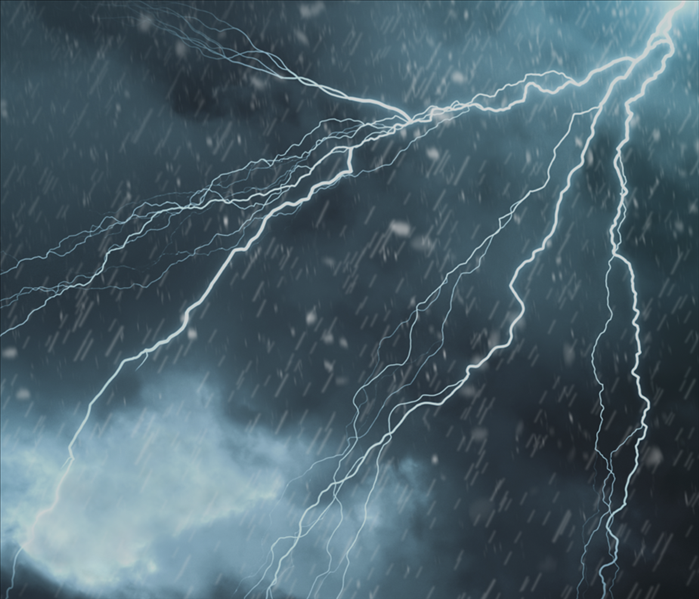 You should contact a storm mitigation company in your Boca Del Mar, FL area when you have a storm damage event.
You should contact a storm mitigation company in your Boca Del Mar, FL area when you have a storm damage event.
Thunderstorms and Workplace Safety: What You Need to Know
A rainstorm unleashes powerful energy into the environment. Not only does it have the potential to bring down torrents of rain and cause flooding, but it also is frequently accompanied by strong winds, thunder, and lightning. If you are not prepared, this can be bad news for your company in Boca Del Mar, FL.
When compared with hurricanes and tornadoes, a thunderstorm usually impacts a much smaller area; however, these storms still pack a wallop and should never be underestimated. One particular storm in Texas in 1995 caused over $2 billion in damages, mostly as the result of hail.
The Role of Lightning in a Rain Storm
Nearly every powerful storm has its share of lightning. These bolts of superheated air can damage property as well as pose a risk to people and animals. A few interesting facts about lightning show its awesome power:
- It can be four times as hot as the sun's surface
- It comes in colors purple, blue, yellow, and white
- It strikes the Earth about 8 million times a day
- It can be up to 90 miles long
Along with high winds and hail, lightning is one of the most destructive forces during a storm. It can even cause structures to ignite.
The Role of Storm Preparation
Your company can limit your exposure to damage by following a few basic guidelines. First, you should always make sure you hold adequate storm insurance for your buildings and other assets. Second, you should develop a plan to prepare for and minimize the impact of storms. This could include such things as strengthening your roof or landscaping your property to divert high waters.
Third, you should contact a storm mitigation company in the event of storm damage. Highly-trained professionals will work to restore your company and reduce costs. A rainstorm has the potential to create significant damage to your company if not taken seriously.
3 Reasons Renters May Need Flood Insurance
4/1/2022 (Permalink)
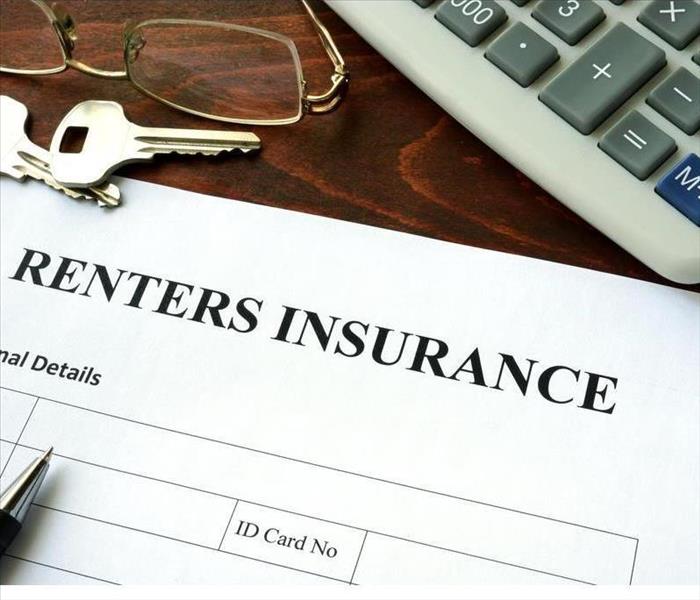 Even if you have renter's insurance, you likely don't have coverage for flood damage.
Even if you have renter's insurance, you likely don't have coverage for flood damage.
Listed Below Are Three Reasons Why Renters May Require Flood Insurance.
As a Highland Beach, FL, tenant, you might assume that you don't need flood insurance. After all, you won't be responsible for restoring the building in the case of water damage, right? The thing is, any of your personal belongings inside that building could quickly become damaged in the event of a flood. Consider these 3 reasons you may need flood insurance.
1. You Already Have Renter's Insurance
Even if you have renter's insurance, you likely don't have coverage for flood damage. Standard renter's insurance policies won't cover water damage caused by storms and flooding. If you already have renter's insurance, check your policy and seek out a separate flood policy to make sure you are covered.
2. You Live in a High-Risk Area
All homes carry some risk of flood damage, and adding flood insurance to your renter's insurance keeps you better protected. However, high-risk areas are especially vulnerable to water damage and in need of coverage. Check out FEMA's Flood Map to see whether you live in a high-risk zone. Renters typically do not fall under the requirement to have flood insurance in high-risk areas, but it is a good indicator of the level of risk you take on by not having insurance coverage.
3. You Are Not Prepared to Replace Your Belongings
Water damage can get very expensive. Just one inch of flooding may damage several thousand dollars' worth of your personal property. Compare the costs of replacing your belongings with the cost of available flood insurance policies as you weigh the risks and benefits of coverage. If you are prepared to replace all of your important items at a moment's notice, having insurance coverage may be less vital. If replacing a large portion of your belongings would be a struggle for you, flood insurance can help you to keep your bases covered.
Most renters are aware of the benefits of renter's insurance, but you may not have realized that flood damage isn't covered on standard policies. If you live in a high-risk area, or you just want to make sure you can replace your belongings if needed, find a flood insurance policy that will keep you protected.
Take These 3 Steps to Prevent Further Wind Damage
3/22/2022 (Permalink)
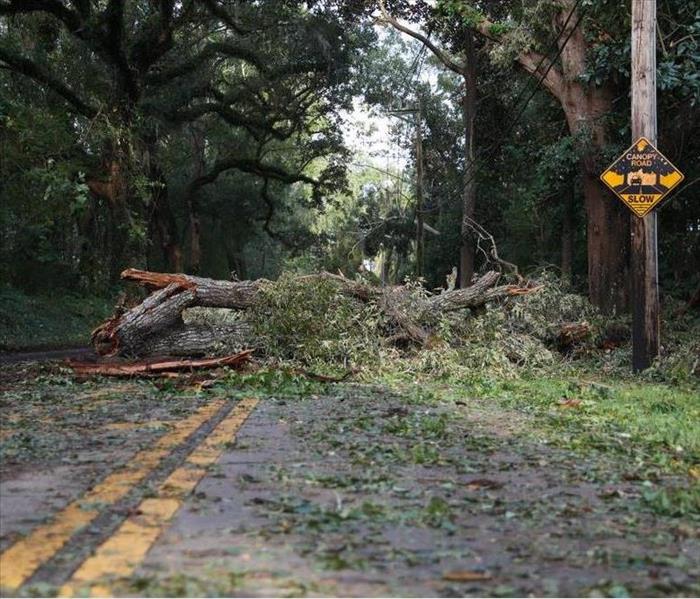 Storms and wind gusts can be strong enough to force even sturdy plant life against your structure.
Storms and wind gusts can be strong enough to force even sturdy plant life against your structure.
Take These Three Steps to Avoid More Wind Damage
Your Highland Beach, FL, business being ravaged by powerful wind exposes it to multiple issues such as a roof leak and decreased security. The repairs might take some time to complete so you will need to prevent damage escalation in the meantime. Take the following steps to protect the building during this vulnerable stage, ensure a faster restoration and avoid additional costs.
1. Call the Professionals
Depending on the level of wind damage, you will likely need outside help not just repairing the damage, but also preventing anything that could worsen it. For instance, a storm repair team will include additional measures that control the existing damage. Roof specialists can also assist with issues ranging from missing shingles to large openings. Do not forget to record and document all the existing damage to present it to both repair professionals and your insurance agent for efficient results.
2. Use Tarp and Plywood
Another way to prevent growing damage, a roof leak or potential trespassing is using materials such as tarp and plywood to cover any potential openings. Any unauthorized entrance can severely set back any progress made in the reconstruction procedure. Additionally, these materials provide some structure that can delay deterioration. Use tarp on a damaged roof to prevent more elements from entering the area and board up lower windows, doors and ground-level openings. Again, hire experienced contractors to handle this task.
3. Remove Any Trees
If your business is located near trees or large plants, there is a strong chance some may have fallen through the building. Storms and wind gusts can be strong enough to force even sturdy plant life against your structure. Fallen trees can create devastating damage, which can get worse if left alone or moved incorrectly. Protect your property and hire a tree company to inspect and remove the trees.
The recovery of your business can get complicated by additional damage such as a roof leak. Work with established contractors to mitigate the effects of wind damage.
Four Ways to Prepare Your Business for Bad Weather
1/27/2022 (Permalink)
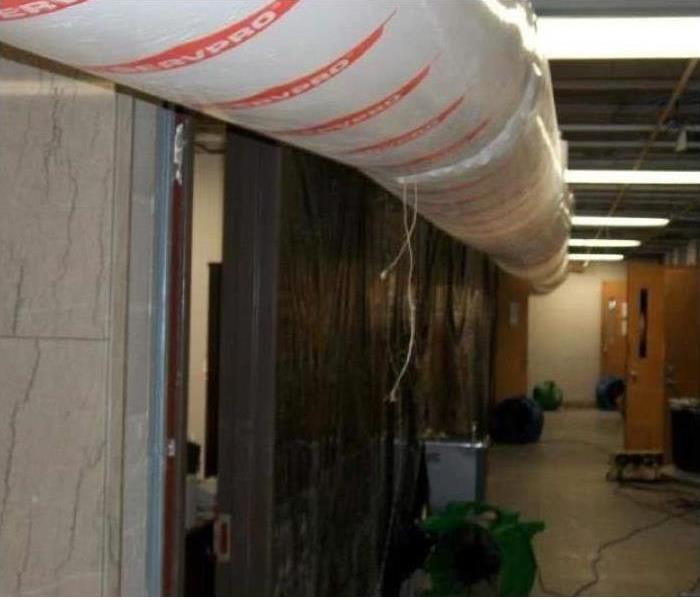 A sudden storm created a massive water damage at this property. No matter what size disaster might confront you, SERVPRO will be standing by 24/7/365
A sudden storm created a massive water damage at this property. No matter what size disaster might confront you, SERVPRO will be standing by 24/7/365
Four Ways To Get Your Business Ready For Storms
When you are expecting bad weather such as a snow storm in Boca Raton, FL, it might be tempting to carry on business as usual. However, this is rarely a good idea. Storms can create an unsafe environment for you and your workers, so you should make sure that you are properly prepared. Here are some ways to keep your business safe during bad weather.
1. Watch the News to Stay Informed
The first step in being prepared is to stay informed. If you don’t know what is happening, you can’t protect yourself or your business from it. You should make sure to watch the local news and weather reports when you are expecting a big rain or snow storm so you can plan accordingly.
2. Have a Bad Weather Policy
It is a good idea to create a policy for bad weather before you need it. That way you can ensure that all of your employees know what is expected of them in an emergency situation. Having a thorough bad weather policy that includes procedures for a variety of weather conditions will enable everyone to be on the same page. Be sure to include information on when workers will and will not be expected to come into work.
3. Create an Evacuation Plan In Case Of Emergency
If you have employees working during inclement weather, it is important to have an emergency evacuation plan in case things turn bad quickly. Have a designated escape route that you can use to get everyone to a safe area and make sure everyone is familiar with the plan.
4. Protect Your Building
If you are expecting a storm, you should take steps to protect your building as well as your workers. Focus on protecting against moisture by sealing doors and windows as well as keeping the temperature above freezing. If a pipe burst, it could flood the building and leave you needing water damage repairs.
While a snow storm might just seem like an inconvenience, it can easily turn dangerous. Having a proper plan can keep your business safe.
Effective Flood Prevention Measures for Urban Areas
11/9/2021 (Permalink)
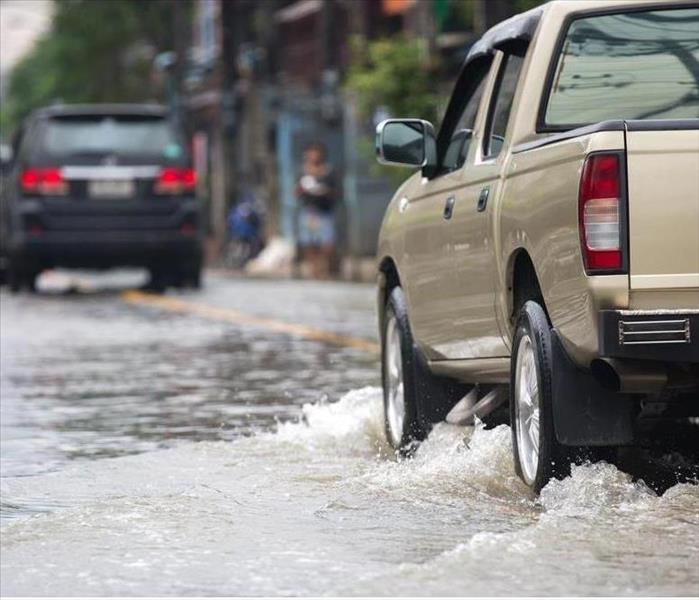 Because every urban area is unique, ideal flood control strategies will vary from city to city.
Because every urban area is unique, ideal flood control strategies will vary from city to city.
Measures to Prevent Flooding In Urban Areas That Work
No business owner in Boca Raton, FL, wants to endure water damage from a flood, but no community is immune from this potential disaster. Significant rainfall can overwhelm drainage and sewage systems and result in high water levels in rivers, lakes and other waterways. Because flood cleanup and restoration endeavors can be costly, every city should employ effective flood prevention measures to protect the interests and wellbeing of the entire community.
Because every urban area is unique, ideal flood control strategies will vary from city to city. Fortunately, a variety of methods exist to help stop flooding.
1. Levees, Dikes and Dams
For towns and cities located near large bodies of water, constructing a levee, dike or dam may be an efficient way to minimize or control high water levels. You can, for example, build a dam across a lake to retain and release water as necessary.
To prevent water from overflowing a river’s banks and inundating the surrounding land, you can utilize levees and dikes, which are embankments built along the water source. Although typically efficient flood prevention measures, dikes and levees can fail under extreme conditions, such as a strong hurricane. For this reason, communities that utilize these measures should also employ additional safeguards to help stop flooding.
2. Drainage Channels and Detention Basins
Drainage channels and detention basins can also help reduce an urban area’s flood risk by providing designated areas for water to flow away from streets, homes and businesses. Detention basins also temporarily store water, helping to reduce the rate of runoff into the storm sewer. This may prevent the system from becoming inundated.
3. Separate Rainwater and Sewer Water Pipes
Recognizing that excessive rainfall can overwhelm the sewer system, some urban communities are updating their infrastructure and providing separate pipes for rainwater and sewer water. This technique may help prevent damage and enhance the city’s water management capacity.
High water levels can severely damage homes and businesses. To provide peace of mind to both residents and business owners, every urban area should have well-designed and efficient mechanisms in place to manage water levels and help prevent flooding.
Preparing for Flood Damage
9/19/2021 (Permalink)
 It is important to remember that remediation services are only a phone call or email away.
It is important to remember that remediation services are only a phone call or email away.
Homeowners in Boca Raton, FL, are like many homeowners all over the country: cognizant that flooding in any season is a potential threat and that working to minimize its destruction makes good sense. Investing time and effort ahead of a deluge is well worth the favorable outcome that can result from a proactive stance.
Proactive Flood Tips
There are many steps that homeowners can take to minimize flood damage in the event that waters rise. Some are straightforward inspection and maintenance issues that can be accomplished relatively quickly and easily.
• Clear debris from gutters and downspouts. If water can move freely through them, it has a better chance of being carried away from basements and foundations.
• Check that outflows from the home are fully operational.
• Install a sump pump or purchase an on-demand submersible pump and drainage hose, and regularly test them.
• Carry adequate flood insurance, especially if the home occupies an area prone to floods. Acquire sandbags and a source for filling them.
• Ensure that storm drains are clear and notify municipal authorities of any blockages that occur.
• Consider elevating appliances such as washers, dryers, and dehumidifiers in basements or other low-lying areas.
• Store irreplaceable documents and valuables off-site, such as in a safe-deposit box.
Plan a Calm Response
In the event that flooding occurs that surpasses efforts to prevent its incursion, it is important to also have a response plan. Monitor local weather alerts and evacuate promptly if directed to do so. Assemble your family and pets. If staying at home is an option, move belongings to higher ground and place electrical appliances at the top. Cut power to avoid the risk of electrocution. Gather needed medications, food, drinking water, phones and their chargers.
It is important to remember that remediation services are only a phone call or email away. Storm damage and flooding remediation can begin as soon as travel becomes safe again.
Cleaning Up After Flood Damage in Boca Raton, FL
8/9/2021 (Permalink)
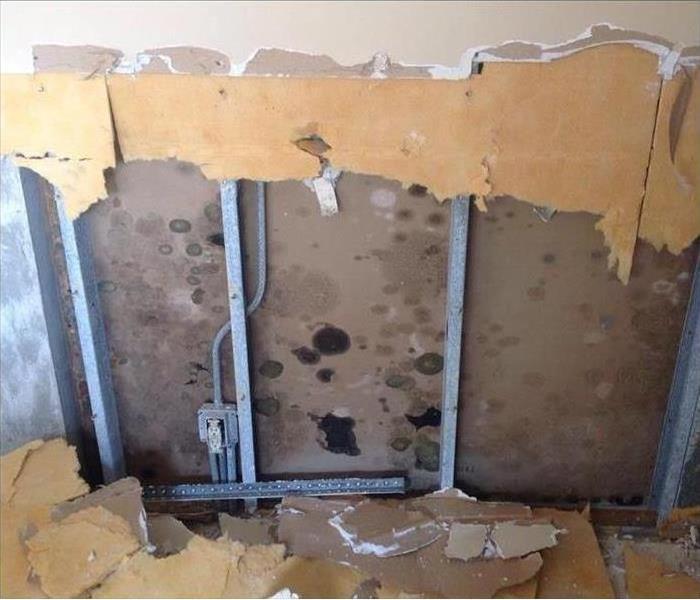 Clean up soon after a flood to prevent mold growth.
Clean up soon after a flood to prevent mold growth.
After A Flood, Mold Removal
The aftermath of a flood in Boca Raton, FL, can be overwhelming. Such widespread damage may be enough to overwhelm your senses, but what you can’t see may be just as alarming. The humidity and moisture following a flood can provide the perfect environment for mold growth in your home.
Safety First
If you are going to enter a home that has suffered flood damage, there are several precautions you should take:
- Check gas and power. Before entering any structure, make sure the gas and electricity are both turned off and look for any damaged gas or power lines.
- Check for structural damage. Make sure there are no sagging ceilings or other structural damage that would make it unsafe to enter the home.
- Cover your hands. If you are going to be handling things that may have mold growth, cover your skin with thick rubber gloves.
- Cover your mouth. Using a handkerchief may not be enough to keep out mold spores. It is best to use a face mask with a respirator to protect your lungs.
- Cover your eyes. Goggles that fit snugly around your eyes can help keep out dust and other small particles. Avoid goggles with air vents, as they will not provide the same protection.
Clean Up
One of the first things homeowners need to do after a disaster is assess the damage to their homes. Documenting the disaster may be helpful for insurance purposes, so photograph each room before beginning cleanup activities.
Next, determine how much of your home was affected. The Environmental Protection Agency says that areas smaller than 10 square feet can often be addressed by the home owner but suggests that anything larger may be best dealt with by remediation professionals.
Time is essential, as bacteria can grow quickly in standing water and mold may grow in as little as 24 to 48 hours. Qualified professionals in Boca Raton, FL, are often the best resources for remediation following a flood because of the tight timeframe and potential for hazardous health conditions if not handled properly.
After a flood, prevent mold growth by cleaning up quickly. Take appropriate safety precautions and contact professionals for expert help.
3 Precautionary Steps for Preventing Roof Leaks
4/1/2021 (Permalink)
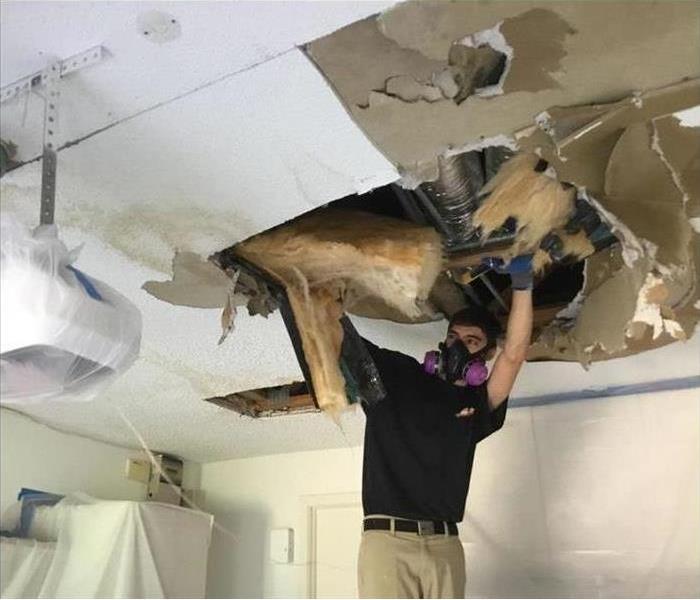 Roof leak in Boca Del Mar, FL
Roof leak in Boca Del Mar, FL
Steps To Avoid A Leaking Roof
There are many things that can lead to a roof leak, from aged, malfunctioning shingles to wind damage from a natural disaster. The presence of one has the potential to cause a great deal of inconvenience and water damage that may require the services of a professional cleanup and restoration company in Boca Del Mar, FL, to deal with. Its existence may promote the growth and spread of mold, compromise structural integrity, create a fire hazard by allowing liquid to drip on live wires and more. There are some steps business owners can take to avoid a leaky roof in the first place.
1. Perform Regular Maintenance
Commercial properties require regular repairs and checkups. One way to head off a potential roof leak is to keep up with some necessary tasks:
- Clean out the gutters and storm drains
- Remove debris from the roof (it can cause water to pool, leading to damage)
- Replace damaged shingles
- Make sure sealant/caulking is working properly
2. Remove Potential Nature Hazards
Trees close to the structure need to be cut down and overhanging branches trimmed off. They have the potential to punch holes in, scratch, rip shingles off and otherwise harm the top of buildings, causing leaks. Getting rid of them is the best way to eliminate the risks they pose.
3. Inspect the Roof Closely
A regular inspection is also vital. The surface of the roof itself, its penetrations (pipes, drains and other components that go through it), the perimeter and the underside all need to be carefully evaluated, especially if severe weather is expected. Holes, cracks, mold, deterioration, rotting materials, wear and tear and missing or broken shingles are all things that can cause trouble and need to be dealt with.
A roof leak can be a pain to deal with. Implementing measures to keep one from occurring in the first place is a good idea and can help commercial property owners avoid a mess.
Storm Damage Can Lead to Mold: Take These 4 Steps To Avoid This Growth
1/18/2021 (Permalink)
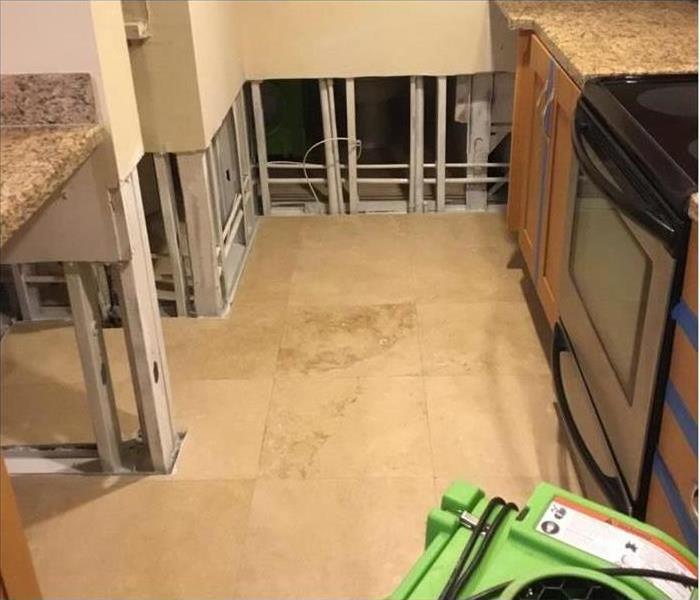 Performing flood cuts in a house in Boca Raton, FL
Performing flood cuts in a house in Boca Raton, FL
Storm Damage Can Lead To Mold
While fungus exists naturally in nature, it can wreak havoc on a home's structure. The spores, triggered by dampness, feed on organic material, eating away at drywall, flooring and ceilings. Left unattended, flooded zones not only create a musty, undesirable odor, but these polluted sections also lead to infested, deteriorated rooms. Thus, homeowners should be vigilant about warding off mold growth by quickly reacting to flood damage. The following four steps assist in reducing mold development and exposure.
1. Carefully Inspect the Moisture Damage
Flooding is tricky as a person's eyes see only part of the problem. The dampness actually exists far below the surface. Special equipment such as moisture readers should be used to examine the location. It's likely that more of the property has been harmed than at first believed. A water restoration company in Boca Raton, FL can perform a thorough assessment to avoid missing any contaminated spots.
2. Remove Saturated Porous Items
Absorbent things such carpet harbor the organisms easily, permitting rapid mold growth. It's extremely difficult to guarantee that cleaning will eradicate any concerns. To prevent unwanted development, tear out anything that is saturated. Personal items harmed and ruined by the fluid should also be tossed. This minimized spore numbers.
3. Complete a Flood Cut
The walls have dampness. To ensure mold removal is complete take out a portion of the drywall. This is often completed two to three feet above the measured exposure.
4. Run Dehumidifiers
Focus on maintaining a dry atmosphere. Dehumidifiers extract moisture from not just the air but also materials. Run them around the clock until readings indicate that the area is back in normal humidity range.
Flood damage, when left unattended or cleaned up improperly, can quickly lead to undesirable mold growth. Homeowners, though, can use certain measures to ward off the trouble. Rely on the knowledge of professionals, and concentrate on eliminating moisture damage.
When Your Business Would Need Commercial Flood Insurance
11/12/2020 (Permalink)
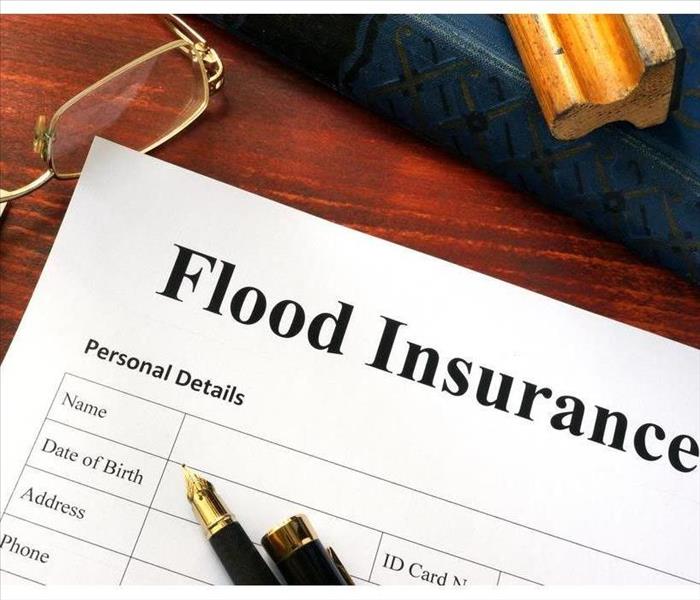 Flood insurance would be essential in these circumstances
Flood insurance would be essential in these circumstances
A flooded building can cause extensive damage and even pose danger to you and your co-workers. Without the right insurance coverage, the cleanup efforts could also be costly and detrimental to your business. Some types of flooding are covered by your regular property insurance. However, there are cases where you would need supplemental flood insurance to repair the damage and replace ruined materials in the building.
What Property Insurance Will Cover
Having a reliable commercial insurance plan should give you peace of mind when a disaster hits. Your regular property coverage should take care of water damage in the following situations:
- Sudden, unexpected bursting of a pipe
- A defective appliance that leaks or ruptures
- Flooding due to burglary or vandalism
Coverage for Overflowing Waterways
If your building is located near a canal, river or other body of water, it's a good idea to purchase supplemental flood insurance. Property insurance will not cover water damage that occurs due to water getting into your building from this source. Flood coverage will pay for the cleanup from a professional flood mitigation company as well as the replacement of any building materials or other items.
Coverage for Sewer Problems
You also wouldn't have coverage in the event of a sewer backup, a broken sewer line or a toilet overflow that might cause flooding in the building. Luckily, flood coverage would help you clean up and rebuild if these issues occurred.
Coverage for Storm Issues
Heavy rains that bring water into your building from underground, through the foundation or other ways, can cause widespread damage to the building. You would need additional insurance to make a claim in these situations. If your building is in Boca Raton, FL where such weather is common, you should speak to your agent about getting this coverage.
Flood insurance would be essential in these circumstances. You can't rely on traditional coverage to come to the rescue in the wake of all types of flooding.
4 Steps To Clean Your Flooded Property
11/8/2020 (Permalink)
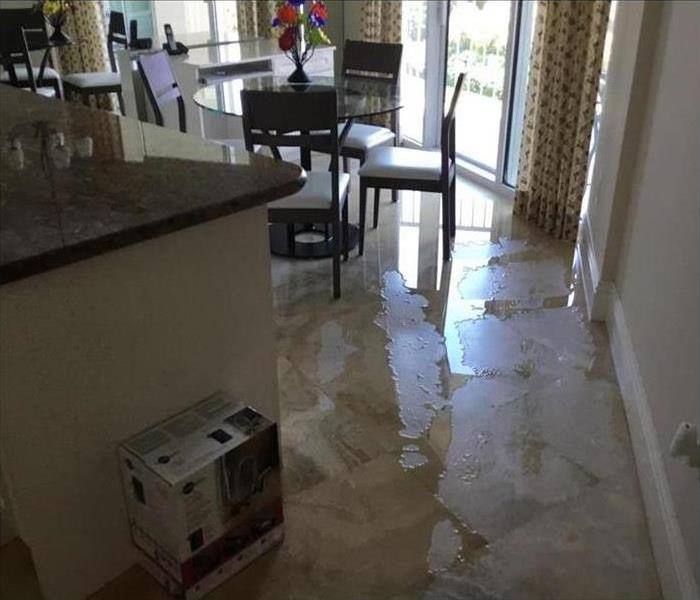 Heavy rains cause flooding in Boca del Mar, FL
Heavy rains cause flooding in Boca del Mar, FL
Four Steps To Get You Started
Floods are often unexpected and can occur quickly, leaving you little time to prepare or protect your belongings. If you've experienced flooding in Boca Del Mar, FL, and are confused about how to clean up afterward, here are four steps to get you started.
1. Dry Wet Areas
Before you get to cleaning, dry the area as much as possible. If water lingers too long, you could have a serious mold problem. Standing water can pose a danger around electronics and damage building materials.
Once you're certain the area is safe, outward-facing fans can help with ventilation without blowing any debris around inside.
2. Use the Right Supplies
Cleaning water damage can involve a lot of materials. You'll potentially be working around mold and cleaning chemicals as well as anything unsanitary brought inside with the water. Disinfectant is crucial; just make sure you're not mixing cleaning supplies. You may also want to look into masks, goggles, gloves or other types of protection before entering the area.
3. Get Your Trash Can
Some materials that have been damaged by flooding can be saved so long as you wash, disinfect and dry them as soon as possible. For other items, it's best to toss them once you've documented the damage for your insurance agent.
4. Ask for Help
Flood damage can be immense, and you may not see the extent of the damage until you begin cleaning. This process often requires many specialized materials, and going about it incorrectly could mean you have hidden damage or mold to deal with later on. Depending on your experience and confidence level, you may be better off consulting a water damage restoration service that has experience with damage from floodwater.
If you've experienced flooding in your home, dealing with the damage can be overwhelming. So long as you're careful and work with an expert, you can start repairing the damage in a safe and effective way.
4 Hidden Damages Storms Cause to Roofs
9/10/2020 (Permalink)
 Strong winds and heavy rain can cause shingles to detach
Strong winds and heavy rain can cause shingles to detach
4 Hidden Damages Storms Cause to Roofs
After a storm hits your commercial building in Whisper Walk, FL, it's important to contact a professional cleanup and restoration service. There are several issues professionals look for when assessing if a roof needs repairs — issues that an inexperienced eye can easily miss. For example, locating a roof leak requires a trained eye, and wind damage can appear minor on the surface. Here are four hidden damages that storms cause to shingled roofs.
1. Missing Shingles
Strong winds and heavy rain can cause shingles to detach. This leaves an opening in your roof. As shingles are the main protection from rainwater infiltrating your building and causing severe damage, it's important to have a professional survey your roof for missing shingles after a severe storm.
2. Damaged Protective Layers
The shingles of your roof are covered in a layer of a tar-like substance that assists in keeping water out of your building. When this layer is battered by storm debris such a loose branches or other objects, the covering can wear away and leave your building vulnerable to a roof leak.
3. A Building Alignment Shift
As repeated storms batter your building, the alignment of the structure can begin to shift. If you notice that windows are hard to open or doors are sticking, this may be the culprit. This is a serious issue that also affects the integrity of your roof.
4. Flashing Tears
Flashing is the sealant that covers gaps and cracks between joining sections of a roof. High winds can lift this protective sealant and cause it to tear. When the storm passes, these tears would not even be visible from the ground.
Storm damages such as a roof leak can quickly become a much bigger issue. It's essential that you call a professional storm cleanup team to inspect your roof so an insurance claim can be filed. Otherwise, as a commercial building owner, you risk losing more time and money the longer you wait. Don't wait; storm and wind damage are serious issues that can catch you unawares.
4 Tips for Storm Season Preparation
9/8/2020 (Permalink)
Follow These Tips to Keep Your Building Safe and Dry Through Most Storms
If a natural disaster occurs in Mission Bay, FL, you may not be able to avoid significant damage to your commercial building. With the proper preparation, however, you can weather the average spring storm just fine. Follow these tips to keep your building safe and dry through most storms.
1. Direct Water Away From Building
You can minimize the risk of storm damage by redirecting the flow of floodwaters. If the storm brings a heavy rain, clear gutters and properly angled downspouts can ensure that it stays away from your building's foundation. If you notice water pooling near your building after a storm, have your landscapers rebuild the slope of the area to angle away rather than toward the base of the structure.
2. Install Sump Pumps
Having sump pumps in your basement can curtail a flooding problem before it gets out of hand. If a storm or a pipe break floods your basement, the sump pump activates and starts to pump the water out before it has a chance to cause extensive damage that only water restoration experts can fix. It's a good idea to hook it up to your backup generator, just in case the storm causes a power outage.
3. Block Flood Waters
It's a good idea to have sandbags on hand during spring storm season. Sandbags can be used around the perimeter of your building and in front of doors and windows to provide an extra line of defense against encroaching water.
4. Watch the Weather
Awareness can be a powerful prevention measure during storm season. Keep an eye on the local weather reports, particularly on days when conditions are likely to produce more than just a light shower. Knowing that the storm is coming in advance gives you more time to activate your plans.
Knowing how to protect your building can save you a lot of time and money. Damage from a spring storm can be avoided if you take the proper precautions.
What to Do After Flooding
8/10/2020 (Permalink)
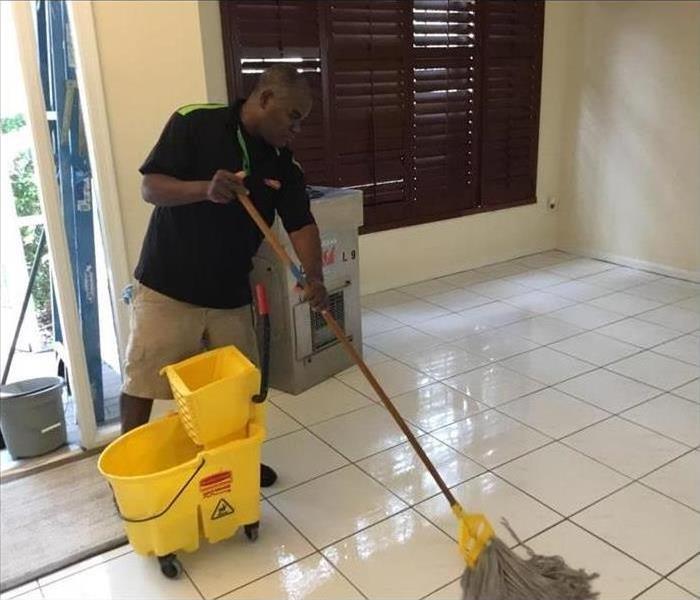 Water cleanup services in Mission Bay, FL
Water cleanup services in Mission Bay, FL
Water Cleanup Process
Flooding, whether from plumbing, weather or other causes, can wreak havoc on your Mission Bay, FL, home. Fortunately, acting quickly can mitigate further damage. The following steps outline the water cleanup process.
1. Assess the damage. When dealing with water damage, first take stock of the damage. Make sure it is safe to return to the property. You may need to call an electrician to turn off the power. Contact your insurance agent and follow any specific instructions given for documenting the damage. If flood damage occurred over a large area, the company may be busy and you may not have time to wait for an adjuster to come to your home. Be sure to take detailed photo or video evidence to help the company process your claim.
2. Remove standing water. Mold growth can begin within 24 hours, so it is important to dry out the property as soon as possible. Remove standing water using pumps or specialized vacuums. You can scoop out the water using buckets if you need to.
3. Dry remaining water. After the standing water has been removed, there will still be moisture within porous items. Dry these out using dehumidifiers and fans. If the humidity outdoors is low enough, you can open the windows and doors to increase airflow.
4. Clean affected areas. Flooding often results in bacterial contamination. The source of the water and the item being cleaned will determine the best cleaner for you to use. Anything that cannot be fully cleaned and dried should be thrown away.
5. Repair and replace damaged items. Some repairs you may be able to do yourself. Delicate items like antiques and electronics may need to be professionally restored.
Cleaning up flood damage can be overwhelming. Fortunately, if your home experiences flooding, an experienced restoration company can help you get your home back to normal quickly and safely.
Cleaning Sewage Backup in a Bathtub
5/2/2020 (Permalink)
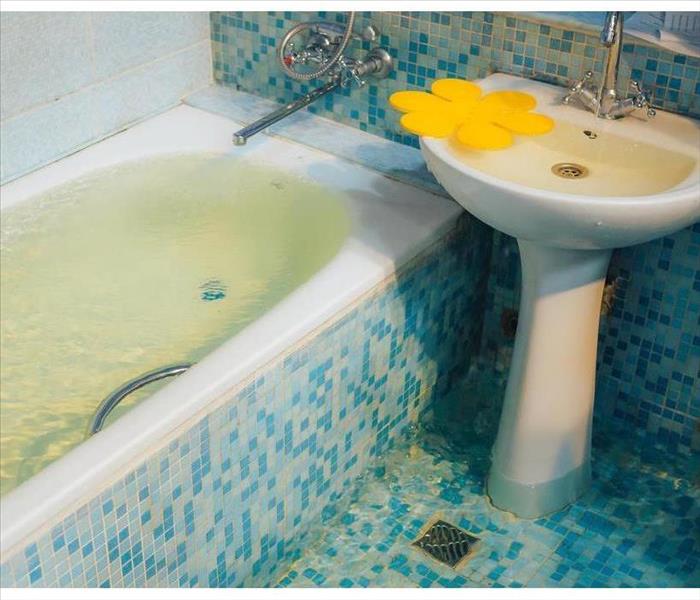 Sewer backup in a Whisper Walk, FL bathroom
Sewer backup in a Whisper Walk, FL bathroom
Let’s face it: Sewer backup into your home is just about the most disgusting thing that can happen. Bathtub backup is a close second.
Unfortunately, when you have backed-up bathtub, it often doesn’t stay in the bathtub. It overflows and spreads. Read on to discover what steps can you take when this happens, what can you clean by yourself, and when should you call water damage experts in Whisper Walk, FL.
Steps To Take On Your Own
Regardless of whether or not you decide to enlist professional help, there are a few things you can do as soon as the backup happens:
- Get your family and pets out of the house.
- Move any items that are in danger of contamination outside of the sewer backup danger zone.
- Call your utility companies to turn off your water, electricity, and gas.
- Open windows as soon as possible to try to dry the area; mold growth can start as soon as 24 hours after flooding.
- Close doors to restrict the contamination, if possible.
- Throw away any items that have already been contaminated.
- Check with your insurance to see what coverage you have.
When To Call an Expert
It can be difficult to clean a backed-up sewer or bathtub on your own in a safe and effective manner. An expert in emergency restoration services should be called to do the following:
- Remove the standing sewer water
- Dispose of any debris that remains after the water has been removed
- Remove any carpet or flooring that has been contaminated
- Wash the walls and floors with disinfectant
- Inspect your home for mold
It is especially important to call an expert if the backed-up mess has been sitting in your home for 24 hours or more, or for an unknown amount of time. The longer it sits, the more dangerous it becomes, and the more damage it can do to your home.
Both time and safety are of the essence after a sewer backup. Act quickly to salvage what you can, and don't hesitate to enlist the help of trained technicians.
Thunderstorms Are a Significant Threat for Businesses
4/13/2020 (Permalink)
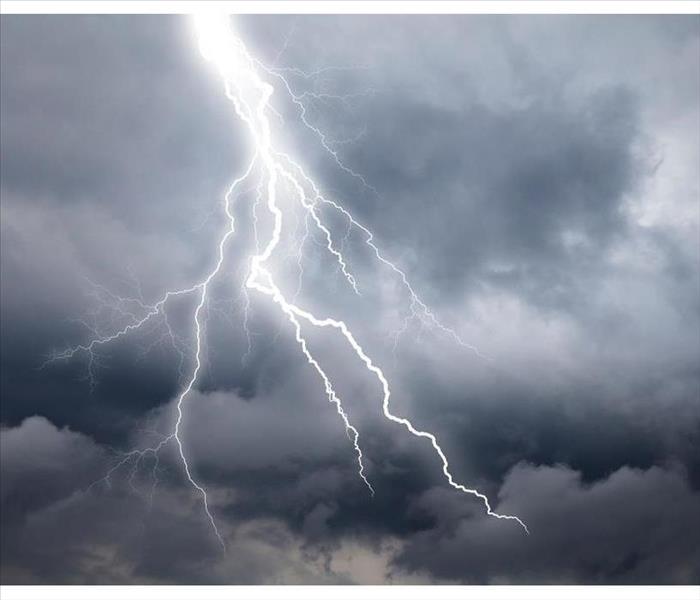 Thunderstorm in Boca, FL
Thunderstorm in Boca, FL
When a thunderstorm blows through, there’s a chance it may turn severe. Devasting hail, damaging winds, and even tornadoes are produced by severe storms, and even thunderstorms that don’t turn severe can have deadly consequences. Almost every year, thunderstorms in Boca, FL, as well as a rain storm without lightning, will damage commercial buildings to some degree, and, at times, can obliterate a commercial operation.
Thunderstorms Have 3 Main Threats to Persons and Property
While tornadoes get most of the attention, they aren’t the main concern with most thunderstorms. A severe thunderstorm can produce
- Damaging winds
- Deadly lightning
- Flood damage
In fact, floods are the leading cause of storm deaths in the United States, with an average of around 100 deaths per year. Lightning is also a big threat, with an average of 51 deaths per year in the U.S. However, recent attempts at educating the public about the dangers of lightning have reduced it to only 27 deaths per year in the last decade.
For a thunderstorm to be considered severe, it must either produce hail greater than 1 inch in diameter, winds exceeding 58 miles per hour or a tornado. The single greatest immediate threat to commercial properties during thunderstorms is typically high winds. Rain damage, however, is the most important long-term threat, since severe thunderstorms are much rarer than a heavy rain.
Preventing Storm Damage to Your Business
Probably the best way to avoid damage to your business is to take some simple precautions. Make sure that trees near your building are properly trimmed and that nothing obvious is loose on the roof. Lightning rods can help reduce the risk of fires and employees being shocked as long as the rods are properly grounded. During a lightning storm or high winds, keep employees and customers away from windows.
If a rain storm or winds have damaged your business in Boca, FL, call a top local storm cleanup company immediately so that they can tarp and board the damaged areas. They can then inspect for hidden damage and begin the restoration process.





 24/7 Emergency Service
24/7 Emergency Service
















